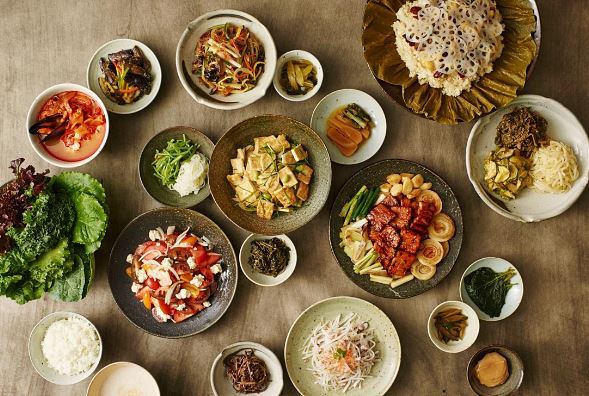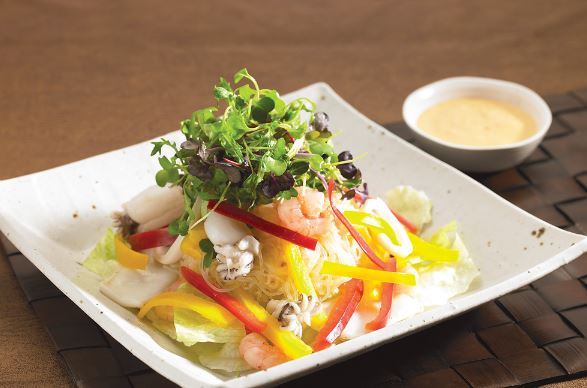Ha Jung-yun, 37, who enjoys exploring gourmet restaurants, has written more posts about Korean restaurants on her Facebook page over the past year.
“It is fun to taste Korean fusion food, served at a newly opened restaurant with a modern look and at a reasonable price,’’ she said.
Modern takes on Korean cuisine, better known as hansik, are a new trend in the restaurant scene here.
“I like modern hansik because it is lighter and experimental, while using healthy and fresh ingredients,’’ Ha said.
“The table decorations and lighting with a modern twist also offer me a comfortable dining experience.’’
Hansik restaurants, once isolated in the dining market with a large gap between high- and low-end, have taken off in recent years, finding a comfort zone in the middle market.
In line with a growing number of health-conscious foodies, food and retail giants, including CJ Group, Shinsegae and E-Land, have triggered the hansik boom, opening modern style Korean restaurant brands.
“It is fun to taste Korean fusion food, served at a newly opened restaurant with a modern look and at a reasonable price,’’ she said.
Modern takes on Korean cuisine, better known as hansik, are a new trend in the restaurant scene here.
“I like modern hansik because it is lighter and experimental, while using healthy and fresh ingredients,’’ Ha said.
“The table decorations and lighting with a modern twist also offer me a comfortable dining experience.’’
Hansik restaurants, once isolated in the dining market with a large gap between high- and low-end, have taken off in recent years, finding a comfort zone in the middle market.
In line with a growing number of health-conscious foodies, food and retail giants, including CJ Group, Shinsegae and E-Land, have triggered the hansik boom, opening modern style Korean restaurant brands.


Promoting the health of Korean cuisine, these Korean nouvelle cuisine restaurants vary from bistros to buffet chains and fine dining.
CJ Group, the nation’s largest food product provider, has been a frontrunner in the modern hansik restaurant chain business. CJ Foodville, the food chain operator of CJ Group, opened the modern hansik buffet restaurant chain Season’s Table last year. The chain, offering around 70 Korean dishes, found success within a year. The restaurant said waits for reservations can be more than a month.
“The entry of big corporations into the hansik market is adding a wide variety to food and restaurant options,’’ Kim Dong-hee, the secretary-general of the Korea Food Foundation.
“There are concerns over their negative impact on the preservation of food traditions, but fusion is a global phenomenon occurring in many countries in this era of globalization.’’
The new wave in the dining scene, rather, has increased the interest in traditional Korean foods, she said.
A growing number of star chefs who learned Western cooking techniques overseas have been inspired by Korean traditional ingredients and dishes, and have begun recreating them in a modern style.
One of the celebrity chefs who is pursuing hansik is Leo Kang. The Western-educated chef learned how to cook authentic Korean food from Han Bok-ryeo, a Korean royal court cuisine specialist, and has invented his own style of fusion Korean food.
He stressed the importance of having a deep understanding of different cuisines in order to create fusion food.
“The modernization of hansik and the preservation of traditions are two different areas and we can seek both, separately,’’ Kim said.
By Seo Jee-yeon (jyseo@heraldcorp.com)







![[KH Explains] Hyundai's full hybrid edge to pay off amid slow transition to pure EVs](http://res.heraldm.com/phpwas/restmb_idxmake.php?idx=644&simg=/content/image/2024/04/18/20240418050645_0.jpg&u=20240419100350)






![[From the Scene] Monks, Buddhists hail return of remains of Buddhas](http://res.heraldm.com/phpwas/restmb_idxmake.php?idx=652&simg=/content/image/2024/04/19/20240419050617_0.jpg&u=20240419175937)

![[KH Explains] Hyundai's full hybrid edge to pay off amid slow transition to pure EVs](http://res.heraldm.com/phpwas/restmb_idxmake.php?idx=652&simg=/content/image/2024/04/18/20240418050645_0.jpg&u=20240419100350)

![[Today’s K-pop] Illit drops debut single remix](http://res.heraldm.com/phpwas/restmb_idxmake.php?idx=642&simg=/content/image/2024/04/19/20240419050612_0.jpg&u=)